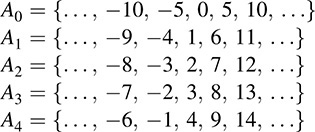Odds and Ends
D.1 Introduction
This appendix discusses various topics, such as equivalence relations and singular value decomposition.
D.2 Relations and Equivalence Relations
A binary relation or simply relation R from a set A to a set B assigns to each ordered pair (a, b) ∈ A × B exactly one of the following statements:
(i) “a is related to b,” written a R b, (ii) “a is not related to b” written a R = b.
A relation from a set A to the same set A is called a relation on A.
Observe that any relation R from A to B uniquely defines a subset  of A × B as follows:
of A × B as follows:

Conversely, any subset  of A × B defines a relation from A to B as follows:
of A × B defines a relation from A to B as follows:

In view of the above correspondence between relations from A to B and subsets of A × B, we redefine a relation from A to B as follows:
DEFINITION D.1: A relation R from A to B is a subset of A × B.
Equivalence Relations
Consider a nonempty set S. A relation R on S is called an equivalence relation if R is reflexive, symmetric, and transitive; that is, if R satisfied the following three axioms:
[E1] (Reflexivity) Every a ∈ A is related to itself. That is, for every a ∈ A, a R a.
[E2] (Symmetry) If a is related to b, then b is related to a. That is,
if a R b, then b R a.
[E3] (Transitivity) If a is related to b and b is related to c, then a is related to c. That is, if a R b and b R c, then a R c:
The general idea behind an equivalence relation is that it is a classification of objects that are in some way “alike.” Clearly, the relation of equality is an equivalence relation. For this reason, one frequently uses or to denote an equivalence relation.
(a) In Euclidean geometry, similarity of triangles is an equivalence relation. Specifically, suppose α, β, γ are triangles. Then (i) α is similar to itself. (ii). If α is similar to β, then β is similar to α. (iii) If α is similar to β and β is similar to γ, then α is similar to γ.
(b) The relation ⊆ of set inclusion is not an equivalence relation. It is reflexive and transitive, but it is not symmetric because A ⊆ B does not imply B ⊆ A.
Equivalence Relations and Partitions
Let S be a nonempty set. Recall first that a partition P of S is a subdivision of S into nonempty, nonoverlapping subsets; that is, a collection P = {Aj} of nonempty subsets of S such that (i) Each a ∈ S belong to one of the Aj, (ii) The sets {Aj} are mutually disjoint.
The subsets in a partition P are called cells. Thus, each a ∈ S belongs to exactly one of the cells. Also, any element b ∈ Aj is called a representative of the cell Aj, and a subset B of S is called a system of representatives if B contains exactly one element in each of the cells in {Aj}.
Now suppose R is an equivalence relation on the nonempty set S. For each a ∈ S, the equivalence class of a, denoted by [a], is the set of elements of S to which a is related:

The collection of equivalence classes, denoted by S/R, is called the quotient of S by R:

The fundamental property of an equivalence relation and its quotient set is contained in the following theorem:
THEOREM D.1: Let R be an equivalence relation on a nonempty set S. Then the quotient set S/R is a partition of S.
EXAMPLE D.2 Let be ≢ the relation on the set Z of integers defined by x ≡ y (mod 5) which reads “x is congruent to y modulus 5” and which means that the difference x – y is divisible by 5. Then ≡ is an equivalence relation on Z.
Then there are exactly five equivalence classes in the quotient set Z/ ≡ as follows:

Note that any integer x, which can be expressed uniquely in the form x = 5q + r where 0 ≥ r < 5, is a member of the equivalence class Ar where r is the remainder. As expected, the equivalence classes are disjoint and their union is Z:

This quotient set Z/ ≡, called the integers modulo 5, is denoted
Z/5Z or simply Z5:
Usually one chooses {0, 1, 2, 3, 4 } or {–2, –1, 0, 1, 2} as a system of representatives of the equivalence classes.
Analagously, for any positive integer m, there exists the congruence relation defined by

and the quotient set Z/ ≡, denoted by Z/mZ or simply Zm, is called the integers modulo m.
D.3 Properties of AAT and ATA
Let A be any m × n matrix. Then ATA and AAT are both symmetric since

One can also show that ATA and AAT have the same nonzero eigenvalues.
Recall [Theorem 9.14] that a symmetric matrix M is orthogonally diagonalizable, that is, there exists an orthogonal matrix P and diagonal matrix D = [di] such that

where the columns of P are the eigenvectors of M and the di are the eigenvalues of M.
In particular, the symmetric matrix M is called:
(i) positive definite if, for every nonzero u, <u, Mu> = uTMu>0
(ii) positive semidefinite if, for every nonzero u, <u, Mu> = uTMu 0]
In such a case, the diagonal elements in P–1MP = D are: (i) positive, (ii) nonnegative.
ATA is positive definite if A has full column rank since Au ≠ 0 when u ≠ 0; so

Similarly, AAT is positive definite if A has full row rank. since ATu ≠ 0 when u ≠ 0; so

On the other hand, ATA and AAT are always both positive semidefinite.
D.4 Singular Value Decomposition
Let A be any m × n matrix of rank r. Then there exists a factorization of A of the form
A = U Σ VT
where U is an m-square orthogonal matrix, V is an n-square orthogonal matrix, and Σ = [σij] is an m × n generalized diagonal matrix, that is, σij = 0 for i σ j. Such a factorization is called a singular value decomposition (SVD) of A, and the diagonal entries σi = σii of Σ, usually listed in descending order, are called the singular values of A.
THEOREM D.2: Every matrix A with rank r>0 has a singular value decomposition.
We indicate how the entries U, V and Σ in the SVD of A are obtained.
Recall AAT is symmetric and positive definite (or positive semidefinite). Accordingly, AAT is orthogonally diagonalizable, that is, AAT = P 7 1DP = PTDP where the columns of the orthogonal matrix P are eigenvectors of AAT, and the entries of D are the eigenvalues of AAT and they are nonnegative.
Assuming A = U Σ VT, we have

Thus the columns of U in the SVD of A are the normalized eigenvectors of AAT and the entries σi in Σ are the square roots of the eigenvalues of ATA.
Similarly, assuming A = U Σ VT, we have

Thus the columns of V and the rows of VT are the normalized eigenvectors of ATA and the entries si in S are the square roots of the eigenvalues of AAT (which are the same as the eigenvalues of ATA).
EXAMPLE D.3. We find the singular value decomposition (SVD) of  . Note
. Note

The eigenvalues are 32 and 18 with corresponding eigenvectors [1, 0]T and [0,1]T. Thus

Also

Hence Δ(t) = t2 – 50t + 576 = (t – 32)(t – 18). Thus, again, the eigenvalues are 32 and 18.
The normalized corresponding eigenvectors are  and
and  . Thus
. Thus

As expected,

